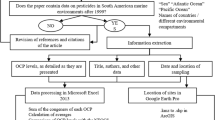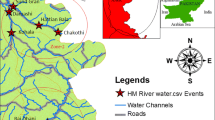Abstract
Background
Organochlorine pesticides (OCPs) have been dispersed ubiquitously in the environment. Bottom sediments act as sinks for these compounds and their concentrations often reflect the degree of anthropogenic pollution. This study was designed to evaluate the occurrence and distribution of OCPs in superficial streambed sediments and their relation to land use in two creeks that contribute to the coastal pollution of the southeastern region of Argentina.
Methods
Sampling sites were selected by a combination of land use and stream type. Las Brusquitas creek, which passes through vast agricultural areas, and La Tapera creek which originates in a natural wetland and passes through horticultural farming and urban areas. OCPs quantification was carried out by GC-ECD.
Results and Discussion
Results showed similar total OCP concentrations in sediments from both creeks in the range of 6–25 ng/g dry wt. However, when OCPs were expressed in ng/g total organic carbon (TOC), La Tapera creek presented 4-fold higher total levels as a consequence of a higher OCP input during the recent past in that watershed. La Tapera outfall showed 4-fold higher levels than that seen in Las Brusquitas, although both values were below the sediment quality criteria demanded to protect wildlife. ΣZEndosulfans, ΣDDTs and Σchlordanes were the main OCP group in all samples, with Endosulfan sulfate being the most frequent and abundant compound. The predominance of metabolites with respect to parent compounds suggests a contamination mainly by runoff from aged and weathered agricultural soils.
Conclusions
Despite OCPs being banned, they still exist in creek sediments from the studied region, representing continuous contributions of land-based source contaminants to the marine environment.
Outlook
Future research on OCP levels in suspended sediments is recommended in order to determine the total OCP concentrations in the selected stream systems.
Similar content being viewed by others
References
Baxtor RM (1990): Reductive dechlorination of certain chlorinated organic compounds by reduced haematin compared with their behavior in the environment. Chemosphere 21, 451–458
Forget G (1991): Pesticides and the third world. J Toxicol Environ Health 32, 11–31
Gatehouse JS (1971): Sedimentation Analysis. In: RE Carver, eds., Procedures in sedimentary petrology. Chapter 4. University of Georgia, Georgia, USA.
Gao JP, Maguhn J, Spitzauer P, Kettrup A (1998): Sorption of pesticides in the sediment of the Teufelsweiher pond (Southern Germany). I: Equilibrium assessments, effect of organic carbon content and pH. Water Res 5, 1662–1672
Gonzalez Sagrario MA, Aizpun de Moreno JE, Moreno VJ, Escalante AH (1998): Dynamics of organochlorine compounds in different trophic levels of Los Padres pond, Argentina. I. Pesticides. Environ Sci 6, 153–170
Hites RK, Day HR (1992): Unusual persistence of DDT in some western USA soils. Bull Environ Contain Toxicol 48, 254–264
Keith LH, Crumett W, Wentler G (1983): Principles of environmental analysis. Anal Chem 55, 2210–2218
MacDonald DDA (1994): Review of environmental quality criteria and guidelines for priority substances in the Fraser River basin. Mac Donald Environmental Science Limited, Environmental Conservation Branch, Canada
Massone HE, Martinez DE, Cionchi JL, Bocanegra E (1998): Suburban areas in developing countries and their relationship to groundwater pollution: A case study of Mar del Plata, Argentina. Environ Manag 2, 245–254
Menone ML, Aizpún de Moreno JE, Moreno VJ, Lanfranchi AL, Metcalfe TL, Metcalfe CD (2000): PCBs and organochlorine in tissues of silverside (Odontesthes bonaericnsis) from a coastal lagoon in Argentina. Arch. Environ Contam Toxicol 38, 202–208
Menone ML, Aizpun de Moreno JE, Moreno VJ, Lanfranchi AL, Metcalfe TL, Metcalfe CD (2001): Organochlorine pesticides and PCBs in a southern Atlantic coastal lagoon watershed, Argentina. Arch Environ Contam Toxicol 40, 355–362
Menone ML, Miglioranza KSB, Iribarne OO, Aizpun de Moreno JE, Moreno VJ (in press): The role of burrowing beds and burrows of the SW Atlantic intertidal crabChastnagnatus granulata in trapping organochlorine pesticides. Mar Poll Bull
Metcalfe TL, Metcalfe CD (1997): The trophodynamics of PCBs including mono and non-ortho congeners in the food web of north- Central Lake Ontario. Sci Total Environ 201, 245–272
Miglioranza KSB, Aizpun de Moreno JE, Moreno VJ, Osterrieth ML, Escalante AH (1999): Fate of organochlorine pesticides in soils and terrestrial biota of ‘Los Padres#x2019; pond watershed, Argentina. Environ Poll 105, 91–99
Miglioranza KSB, Gonzalez Sagrario MA, Aizpún de Moreno JE, Moreno VJ, Escalante AH, Osterrieth ML (2002): Agricultural soils as a potential source of input of organochlorine pesticides into a nearby pond. Environ Sci Poll Res 4, 250–256
Miglioranza KSB, Aizpun de Moreno JE, Moreno VJ (2003): Dynamics of organochlorine pesticides in soils from a southeastern region of Argentina. Environ Toxicol Chem 4, 591–599
Sarkar A, Nagarajan R, Chaphadkar S, Pal S, Singbal SYS (1997): Contamination of organochlorine pesticides in sediments from the Arabian Sea along the west coast of India. Water Res 31, 195–200
Walkley A, Black CA (1965): Organic carbon. In: CA Black, eds, Methods of soil analysis. American Society of Agronomy, BC, Wisconsin, USA
Wedemeyer G (1967): Dechlorination of l,l,l-trichloro-2,2-bis(p-chloro-phenyl) ethane byAerobacter aerogenes. App Microb 15, 569–574
Windom HL (1992): Contamination of the marine environment from land-based source. Mar Poll Bull 1–4, 32–36
Zhang G, Min YS, Mai BX, Sheng GY, Fu JM, Wang ZS (1999): Time trend of BHCs and DDTs in a sedimentary core in Macao estuary, southern China. Mar Poll Bull 39, 326–330
Author information
Authors and Affiliations
Corresponding author
Rights and permissions
About this article
Cite this article
Miglioranza, K.S.B., Aizpún de Moreno, J.E. & Moreno, V.J. Land-based sources of marine pollution: organochlorine pesticides in stream systems. Environ Sci & Pollut Res 11, 227–232 (2004). https://doi.org/10.1007/BF02979630
Received:
Accepted:
Issue Date:
DOI: https://doi.org/10.1007/BF02979630




